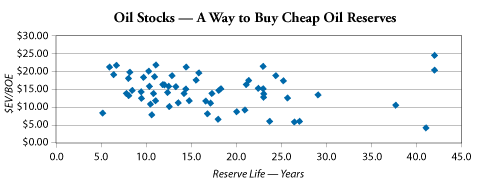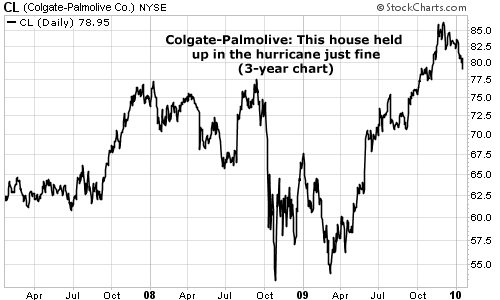| Home | About Us | Resources | Archive | Free Reports | Market Window |
The Most Important Thing to Remember as an Investor in OilBy
Thursday, January 21, 2010
We really don't know as much about the oil market as we think we do.
There are many numbers out there, but most of these involve a lot of guesswork. For example, we really don't know just how much oil the world will need. The U.S. Department of Energy says we'll need 106.6 million barrels a day by 2030, but how does it know? It can't know. It can't know what the world will look like in 2030. We don't really know how much oil we're discovering or how much will actually come to the market any time soon. We don't really know how much it will cost to get this oil. We can guess, but our guesses are frequently wrong. Goldman Sachs wrote in a research report issued in February of last year (230 Projects to Change the World) that the cost of bringing on additional oil sands project would come to $80-$90 a barrel. It sounds nice, but it's a guess. We don't know a lot, even though we put decimal points on lots of numbers as if we knew precisely. And there is plenty of room for people to fudge numbers and make up stuff. It happens all the time. Of course, no one knows what the price of oil will be, but there is no shortage of forecasts. Goldman Sachs says it will be $95 by the end of 2010. Deutsche Bank says $65. They are all guessing. There is one thing we do know. And fortunately, this is the most important thing to remember as an investor in oil: The market is still pricing proved oil reserves at less than replacement cost. In other words, it is cheaper in today's market to buy proven reserves in the stock market than to drill for new ones. I would cite the 2008 reserve and finding cost study published by Howard Weil. It shows the average cost of reserves through the drill bit is about $43 per barrel, with the median (or midpoint) around $25 per barrel. These are hard numbers, not soft guesses. You can do this yourself and find out how much it costs for your favorite oil company to add a barrel of proved oil reserves by drilling for it. So we have a good idea of what it costs to create a barrel of proved oil reserves today. Figuring out these numbers is easier than guessing what the price of oil will be in the future. Granted, even these cost numbers will change. There are no constants. But here is the trick. You want to buy oil companies when you can pick up proved oil reserves for a lot less than what it costs to produce them. In the market, that's where we are today. In fact, you can pick up proved reserves for less than $15 a barrel. Here is a scatter plot by an energy firm I respect a great deal, Lucas Capital Management. It shows you the universe of stocks it follows. EV is enterprise value, which you can think of as the cost to acquire the entire business, both the stock and the debt. So EV/BOE shows you how much you are paying per barrel of oil. It plots this number against reserve life. Take a look:  The math is easy. You have lots of companies here in which you can buy oil in the ground for under $10 a barrel... and remember it costs on average $25 a barrel to replace it. I could not make a more compelling argument for oil stocks than this. Buying for less than replacement costs is one of my main compasses in investing – whether I'm buying potash mines or gold mines or factories or oil rigs or what have you. If I can buy it in the stock market for less than it costs to replace those assets – and as long as I'm not buying buggy whips – then I've got a good chance of making money. That's because the stock market is, after all, just a market. Eventually, prices correct. In the oil market, we'll see more acquisitions. It's cheaper and easier to grow reserves that way. The buying pressure will lift the price of oil stocks so the disparity is not so great. Simple as that. In the case of oil, we are also looking at strong odds that the costs of producing a barrel of oil reserves will go up. Recently, The Wall Street Journal ran a piece titled "Cramped on Land, Big Oil Bets at Sea." Now, you've probably heard of all the big deep-water oil projects. All the major oil companies are moving farther offshore in their quest for oil. The WSJ article leads with this: "Big Oil never wanted to be here, in 4,300 feet of water far out in the Gulf of Mexico, drilling through nearly five miles of rock. It is an expensive way to look for oil." Yes, it is. This is another of the great unknowns. We don't know how much it will cost at the end of the day to get this oil. We know that it will cost a lot. Chevron spent $2.7 billion over 10 years on just the first phase of a deep-water oil project in the Gulf. That's one of the more tame projects. Some of the sub-salt discoveries involve drilling more than 30,000 feet. They will be the most expensive wells ever drilled. You really don't need to know a lot about geology or oil to guess that this deep-water oil is going to be more expensive than the good old oil wells onshore. So the average cost of reserves is likely to go higher. Meaning that if you can lock in quality, low-cost, long-lived reserves today for only $15 a barrel or less – you should do it. That's why you own oil stocks today. Good investing, Chris Editor's note: Chris Mayer is the editor of Capital & Crisis, a monthly advisory we consider required reading at DailyWealth. With Chris' research, you can always count on contrarian investment ideas you won't read about anywhere else. Click here to learn more about Capital & Crisis.
Further Reading:
Asia Is Going to Make Investors Rich with This Commodity Market NotesOUR THIRD "SURVIVOR STOCK"
Like McDonald's, there's no hot story behind our next "survivor" stock...
Today's survivor is Colgate-Palmolive (CL). With a $39 billion market cap, CL is one of America's producers of "the basics." Brands under this umbrella include Ajax (cleanser), Colgate (toothpaste), Irish Spring (soap), Speed Stick (deodorant), and, of course, Palmolive (dish soap). Like most every stock, CL took a beating during the October 2008 market decline. Shares fell from the mid $70s to the mid $50s. But like McDonald's and Royal Gold, Colgate-Palmolive's business model allowed it to decline less than the broad market averages... And unlike the broad market, shares are near an all-time high. Colgate-Palmolive also managed to keep up its incredible 46-year string of uninterrupted and rising dividend payments... a story similar the one Dan Ferris described in his "must read" report, How to be assured all the income you need for the rest of your life, which you can get absolutely free with a subscription to our sister website, The Daily Crux. Dan's idea is one of the most important things you'll ever learn as an investor. 
|
In The Daily Crux
Recent Articles
|

